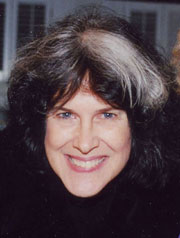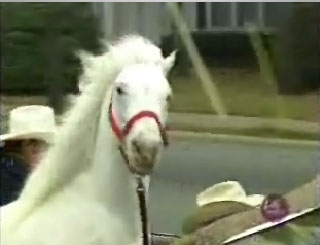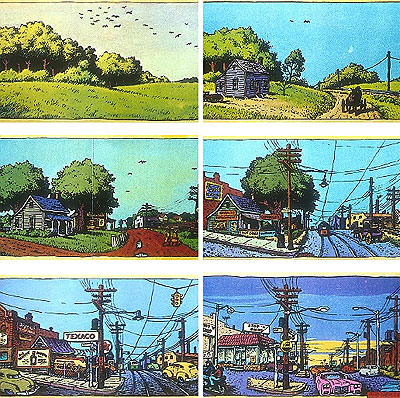 |
→ April 2006 Contents → E-bits
|
E-Bits
O, What a Tangled Web April 2006 |
 |
|
I was thinking about tangled webs and SNAFUs recently, and it occurred to me that things these days are not only rather snarled and tangled, but we are all just too wired, in every sense of the word. So I took it upon myself to unplug and go on an experimental retreat from the wired world for about a week. That meant not using the phone, no checking e-mail, no TV, videos or film, radio or CDs, nor using electronic devices, hair dryers, pocket diaries, battery-powered gadgets, etc. I wanted to remember what it felt like to be disengaged from these technologies, and I must say, it was quite an experience, and a surprisingly pleasant one. At the same time I unplugged from these devices, I also spent several days with an old friend driving from one end of Oregon to the other. Our only concession to modernity was transportation, which we realized we generally and completely take for granted, but now it seemed miraculous to go a mile each minute in our iron horse. We saw magnificent landscapes and the majestic forests, the beautiful Oregon coast and her awesome mountain ranges, between which lies a tranquil desert much like that of New Mexico. All the while we breathed the freshest, possibly most highly oxygenated air I believe I've ever inhaled, and I suddenly felt like I was on another earth, one that existed long before we got here. We spent the night on an Indian reservation, where we experienced the quietest quiet and the nothing-est nothing I can ever remember. From our lodge in the middle of the reservation, the land was empty and undeveloped for as far as my eyes could see, and I could not hear a sound for as far as I could hear except for the ringing in my ears that I usually don't notice because of a constant background noise in "civilization." Explore this HISTORIC PHOTO ARCHIVE that presents many early photos from Oregon and the West, taken not so long ago, when the world was much less wired.
While we drove on the lonely road through the 372,000-acre reservation, we saw wild mustangs running and grazing in the hills, and it was exhilarating to see them in their natural environment. If you explored the site above, you saw some historical photos of horses in the West, but nothing can compare with seeing them running wild and free, knowing they belong to no one and are at home on their own range. On the other hand, not much can compare with the horse you are about to see in the following video clip. Patches is a horse who takes wild rides in his own special way.
We are in an age where it's hard not to be a big fan of many kinds of technology. I couldn't write this column or find amazing things on the Web if it weren't for digital technology. The birth of photography in 1839 soon changed the world, and the lifetime of the photographic medium separates into definitive and analytically interesting phases, just like the life of a person. Just as our experience seems to accelerate as we age, technology has been accelerating at a faster and faster pace. In 1987 we feared that digital technology would overtake traditional methods, and now here we are, with a digital camera in every pocket and an iPod in every ear. We are totally wired. One thing about traveling without even a radio for distraction is that my senses seemed to come alive in a way that can only be described as quite familiar but now nostalgic, and I found myself wanting to leave the wired world behind for more than just a week, if not permanently. R. Crumb's AMERICA and the documentary CRUMB, about the cartoonist's life, both show drawings of the evolutionary sequence of a pastoral landscape as it changes to its contemporary form at the identical location, encroaching wires going every which-a-way as time moves forward. I couldn't help but think about the progression of these images and how it has all happened in so short a time, wondering what's next. What's next, indeed.
I have a very good friend who is an artist, musician, writer and philosopher, who spent the last 25 years -- the last 13 years overseas -- teaching English to ninth graders. He always has said he loved his job, and I have watched him enjoy a quarter of a century of witnessing young minds as they awaken to the world of ideas and thought through studying literature. About three years ago he retired from that profession, and just the other day he shared with me the farewell speech he gave at commencement ceremonies to his last class of graduating ninth graders, their parents, friends and faculty. In that speech he said two things that touched my heart and perhaps will stir you as well. One of the benefits of traveling the world, he told the audience, was the opportunity to see firsthand not how different we are from each other, but how alike we humans are, that superficial differences of culture, language, food and dress in fact mean very little. He pointed out a universal trait among everyone, everywhere, "Every single one of us…recognizes the meaning of a genuine smile," he said. "We all know the importance of friends and family, and we all delight in the sound of a child's laughter, the smell of fresh-baked bread, the colors in a field of wildflowers and the feel of air on our skin on the first cool fall day after a long hot summer. We are all in search of the divine. We are after all, first and last, human beings."
Later in the speech, my friend referred to the existence of human divisiveness, brutality, and suffering in the world, and acknowledged that it may be tempting sometimes to despair, to give up hope, but that he could give more than 100 different reasons not to give up that hope. "They are sitting beside me," he said, "right here on this stage." In working with kids, this seasoned teacher says he has never given up hope because he discovered the one greatest strength that kids have over most adults -- their ability to imagine. They can imagine, he said, beyond the status quo, and have the willingness to imagine they could be wrong, that there is more to learn, that they have the power to transform themselves and in the process, therefore, to transform the world. They hold the power to imagine that anything is possible. He challenged them to hold onto that strength, that it will take courage to continue to see not only with their eyes, but also their hearts, and to understand not only with their minds, but with their spirits as well.
I found my friend's words to his departing students inspiring, and I thought about a world where creative imagination and cooperation are the rule rather than the exception, where positive change is possible, and all of us embrace and hold on to each other for what is most dear to us all -- Life. I think the following video of an 85-person, record-setting parachute formation is the perfect metaphor to illustrate that idea. Planned by a group called CF World Record 2005, it took the 85-member team with participants from nine countries almost 10 minutes to get into formation, demonstrating phenomenal coordination of many parts to achieve an awe-inspiring and thrilling whole. For more about these talented parachutists, see their Web site, but first click on the photo below to see them in action.
One last thought: it may be easy to go nuts in the tangled and crazy, very much wired world of today, but I suggest the best way forward is to find inspiration and delight wherever we can, getting our needs met without causing harm. Speaking of nuts, watch this little guy figure out how to get what he needs under the watchful eye of an oppressive force.
Have a great April!
© Beverly Spicer
The links that appear in this column are from the World Wide Web. Credit is given where the creator is known. The Digital Journalist and the author claim no copyright ownership of any video or photographic materials that appear herein. |
|
Back to April 2006 Contents
|
|



